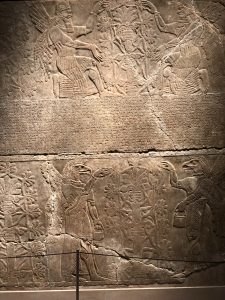
For this assignment, I was very excited to visit the Brooklyn Museum because I live right in Crown Heights and have yet to be able to visit. The museum had a beautiful layout and so many pieces that caused me to be in awe the entire time. Once I finally reached the Ancient World section on the third floor, I found myself remembering and thinking about all of the things we have learned about in class regarding Ancient Mesopotamia and Egypt, and beginning to analyze all of the wonderful works that were displayed. Upon my way out towards the stairs, I stumbled upon the Assyrian Palace Reliefs that all had amazing and intricate details that I became more appreciative of when I saw them in person. I thought the placement of the reliefs near the entrance/exit stairs was very telling as to what they are and their purpose because when you reach the beginning of the exhibit, it explains that these reliefs would be seen at the entrances of Assyrian palaces to “overwhelm” visitors. I remember discussing this in class when we learned of the many figures that would be used to showcase power and attempt to frighten visitors. The relief I found myself in complete awe of was the Relief with Two Registers that came from the Neo-Assyrian Period under the rule of Ashur-nasir-pal II. In doing formal analysis, the first thing I became aware of was the complete symmetry of the two registers. Although they are different characters, they are complete mirror images of one another, even down to the piece that the figures are holding/touching which I later found out was the sacred tree. Also, in doing formal analysis one can take note of the depth of the lines that were used, in some places of the register, both top and bottom, there are certain parts that have deeper lines and others that have more shallow lines. The shallow lines seemed to be used for parts that were not the main focus of the relief, such as clothes; and the deeper lines were used to enhance/showcase detail such as the scared tree of or the wings of the mythical creature and the genie. I also noted that unlike some of the registers we viewed in class, there did not seem to be a hierarchy and instead they were equal to show their equal importance and meaning.


